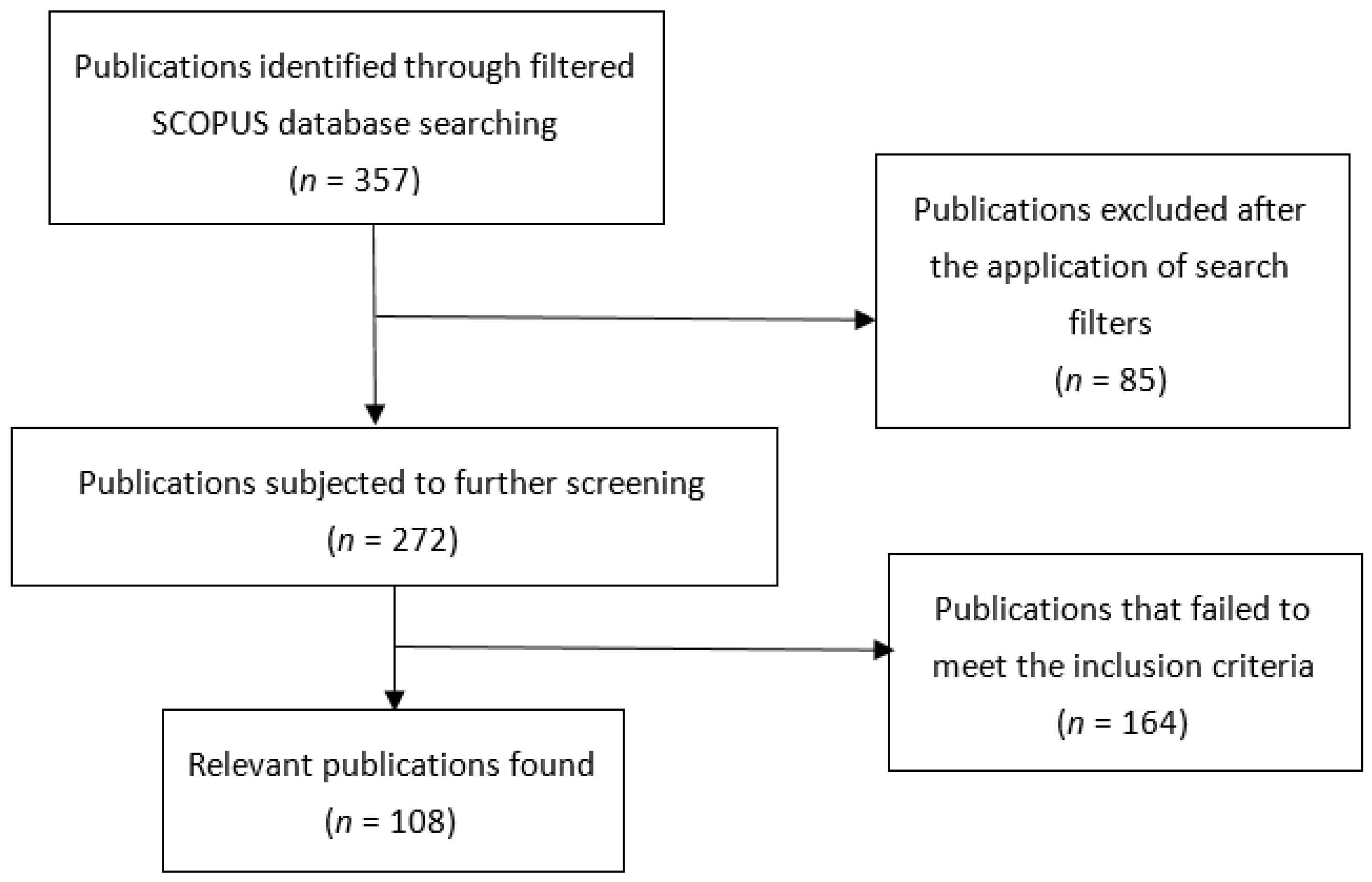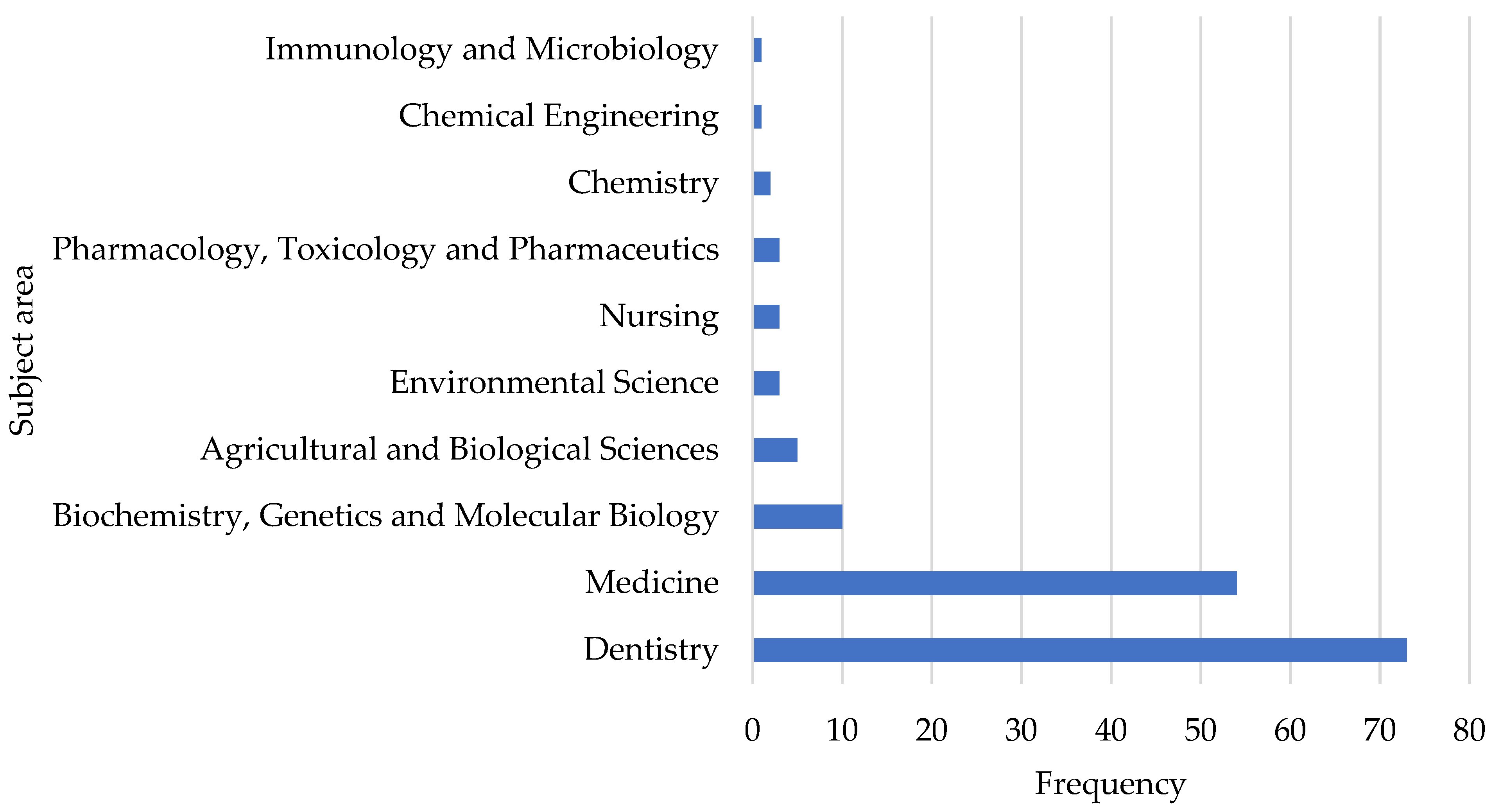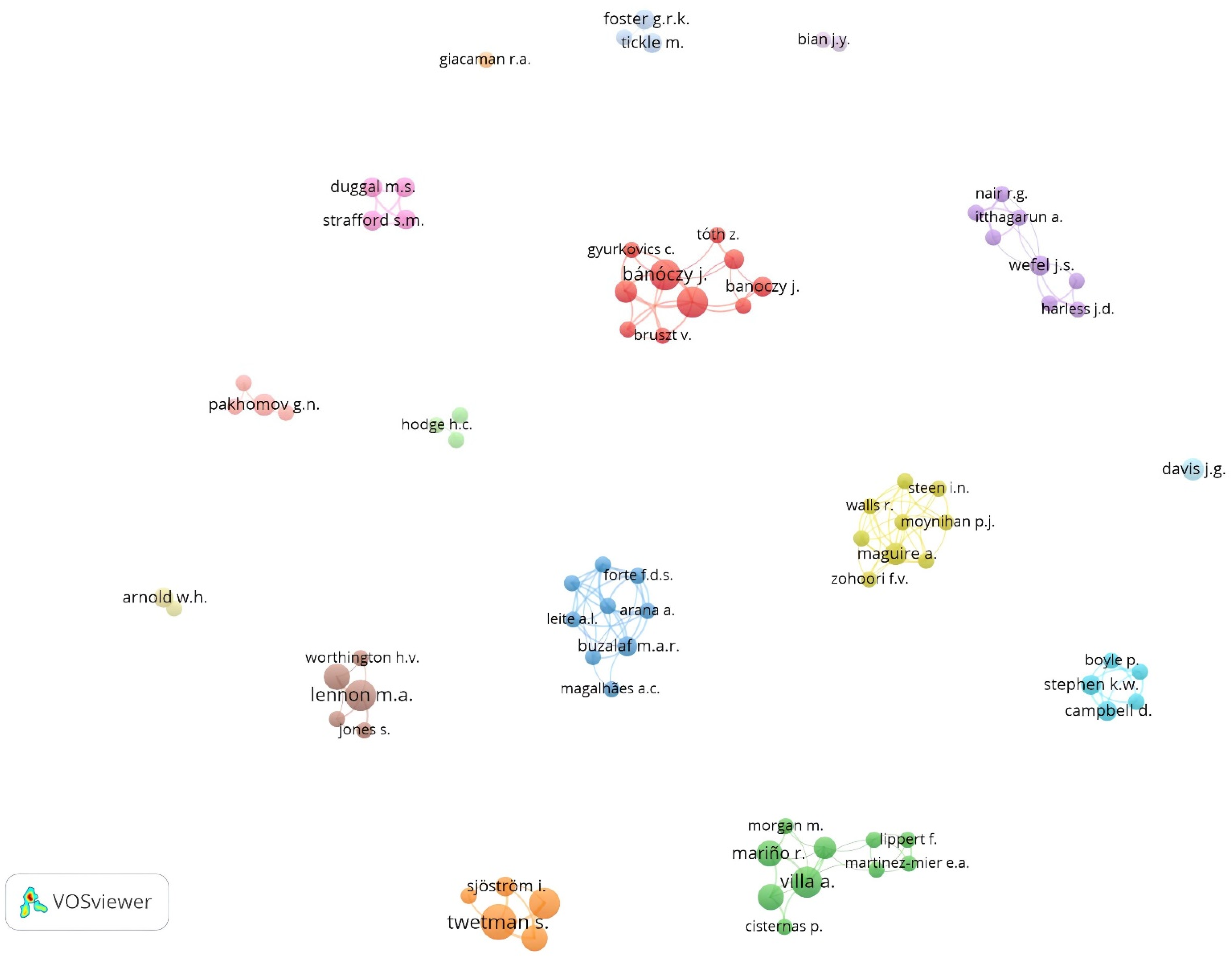A Scopus-Based Bibliometric Analysis of Global Research Contributions on Milk Fluoridation
Abstract
:1. Introduction
2. Materials and Methods
2.1. Study Type
2.2. Data Source
2.3. Data Extraction
2.4. Data Analysis
3. Results
3.1. Description of the Included Studies
3.2. Publication Trends
3.3. Citation Trend
3.4. Subject Areas
3.5. Research Funders
3.6. Top Ten Journals
3.7. Top Ten Authors
3.8. Top Ten Institutions
3.9. Top Ten Countries
3.10. Top Ten Articles
3.11. Network Visualization of Co-Occurrence
3.12. Network Visualization of Co-Authorship
3.12.1. Authors
3.12.2. Institutions
3.12.3. Countries/Territories
3.13. Network Visualization of Citations
3.13.1. Journals
3.13.2. Authors
3.13.3. Institutions
3.13.4. Countries/Territories
4. Discussion
5. Conclusions
Supplementary Materials
Author Contributions
Funding
Institutional Review Board Statement
Informed Consent Statement
Data Availability Statement
Conflicts of Interest
References
- Al Agili, D.E. A systematic review of population-based dental caries studies among children in Saudi Arabia. Saudi Dent. J. 2013, 25, 3–11. [Google Scholar] [CrossRef] [Green Version]
- Petersen, P.E.; Bourgeois, D.; Ogawa, H.; Estupinan-Day, S.; Ndiaye, C. The global burden of oral diseases and risks to oral health. Bull. World Health Organ. 2005, 83, 661–669. [Google Scholar]
- Mathur, V.P.; Dhillon, J.K. Dental Caries: A Disease Which Needs Attention. Indian J. Pediatr. 2018, 85, 202–206. [Google Scholar] [CrossRef]
- Knapp, R.; Marshman, Z.; Gilchrist, F.; Rodd, H. The impact of dental caries and its treatment under general anaesthetic on children and their families. Eur. Arch. Paediatr. Dent. 2020, 22, 567–574. [Google Scholar] [CrossRef]
- Gomes, M.C.; Perazzo, M.F.; Barbosa Neves, É.T.; Firmino, R.T.; Lopes, R.T.; Assunção, C.M.; Ferreira, F.M.; Paiva, S.M.; Granville-Garcia, A.F. The impact of dental pain due to caries in the oral health-related quality of life of children. J. Dent. Child. 2021, 88, 80–85. [Google Scholar]
- Conrads, G.; About, I. Pathophysiology of Dental Caries. Monogr. Oral Sci. 2018, 27, 1–10. [Google Scholar] [CrossRef]
- Maher, R.; Khan, A.; Rahimtoola, S.; Bratthall, D. Prevalence of mutans streptococci and dental caries in Pakistani children. J. Pak. Med. Assoc. 1992, 42, 213–215. [Google Scholar]
- Bowen, W. Dental caries-not just holes in teeth! A perspective. Mol. Oral. Microbiol. 2016, 31, 228–233. [Google Scholar] [CrossRef]
- Carey, C.M. Focus on Fluorides: Update on the Use of Fluoride for the Prevention of Dental Caries. J. Evid. Based Dent. Pract. 2014, 14, 95–102. [Google Scholar] [CrossRef] [Green Version]
- Cate, J.M.T. Contemporary perspective on the use of fluoride products in caries prevention. Br. Dent. J. 2013, 214, 161–167. [Google Scholar] [CrossRef]
- Buzalaf, M.A.R.; Pessan, J.P.; Honorio, H.M.; Ten Cate, J.M. Mechanisms of action of fluoride for caries control. Monogr. Oral Sci. 2011, 22, 97–114. [Google Scholar]
- Whelton, H.; Spencer, A.; Do, L.; Rugg-Gunn, A. Fluoride Revolution and Dental Caries: Evolution of Policies for Global Use. J. Dent. Res. 2019, 98, 837–846. [Google Scholar] [CrossRef]
- Marthaler, T.M. Salt fluoridation and oral health. Acta Med. Acad. 2013, 42, 140–155. [Google Scholar] [CrossRef]
- Iheozor-Ejiofor, Z.; Worthington, H.; Walsh, T.; O’Malley, L.; Clarkson, J.E.; Macey, R.; Alam, R.; Tugwell, P.; Welch, V.; Glenny, A.-M. Water fluoridation for the prevention of dental caries. Cochrane Database Syst. Rev. 2015, 2015, CD010856. [Google Scholar] [CrossRef]
- Bánóczy, J.; Rugg-Gunn, A.; Woodward, M. Milk fluoridation for the prevention of dental caries. Acta Med. Acad. 2013, 42, 156–167. [Google Scholar] [CrossRef]
- Mariño, R.; Morgan, M.; Weitz, A.; Villa, A. The cost-effectiveness of adding fluorides to milk-products distributed by the National Food Supplement Programme (PNAC) in rural areas of Chile. Community Dent. Health 2007, 24, 75–81. [Google Scholar]
- Pakhomov, G.N.; Ivanova, K.; Moller, I.J.; Vrabcheva, M. Dental Caries-reducing Effects of a Milk Fluoridation Project in Bulgaria. J. Public Health Dent. 1995, 55, 234–237. [Google Scholar] [CrossRef]
- Bánóczy, J.; Rugg-Gunn, A.J. Clinical studies. In Milk Fluoridation for the Prevention of Dental Caries; Bánóczy, J., Petersen, P.E., Rugg-Gunn, A.J., Eds.; World Health Organization: Geneva, Switzerland, 2009; pp. 19–65. [Google Scholar]
- Mariño, R.J.; Villa, A.E.; Weitz, A.; Guerrero, S. Caries prevalence in a rural Chilean community after cessation of a powdered milk fluoridation program. J. Public Health Dent. 2004, 64, 101–105. [Google Scholar] [CrossRef]
- Ziegler, E. Uber die Milchfluorierung [Fluoridation of milk]. Bull. Schweiz Akad. Med. Wiss. 1956, 12, 466–480. [Google Scholar]
- Yeung, C.A. A systematic review of the efficacy and safety of fluoridation. Evid.-Based Dent. 2008, 9, 39–43. [Google Scholar] [CrossRef] [Green Version]
- Cagetti, M.G.; Campus, G.; Milia, E.; Lingström, P. A systematic review on fluoridated food in caries prevention. Acta Odontol. Scand. 2013, 71, 381–387. [Google Scholar] [CrossRef]
- Bánóczy, J.; Rugg-Gunn, A.J. Caries prevention through the fluoridation of milk. A review. Fogorv. Szle. 2007, 100, 185–192. (In Hungarian) [Google Scholar]
- O’Mullane, D.M.; Baez, R.J.; Jones, S.; Lennon, M.A.; Petersen, P.E.; Rugg-Gunn, A.J.; Whelton, H.; Whitford, G.M. Fluoride and Oral Health. Community Dent. Health 2016, 33, 69–99. [Google Scholar]
- Zhang, J.; Cenci, J.; Becue, V.; Koutra, S.; Ioakimidis, C.S. Recent Evolution of Research on Industrial Heritage in Western Europe and China Based on Bibliometric Analysis. Sustainability 2020, 12, 5348. [Google Scholar] [CrossRef]
- Ahmad, P.; Slots, J. A bibliometric analysis of periodontology. Periodontology 2020, 85, 237–240. [Google Scholar] [CrossRef]
- Akmal, M.; Hasnain, N.; Rehan, A.; Iqbal, U.; Hashmi, S.; Fatima, K.; Farooq, M.Z.; Khosa, F.; Siddiqi, J.; Khan, M.K. Glio-blastome Multiforme: A Bibliometric Analysis. World Neurosurg. 2020, 136, 270–282. [Google Scholar] [CrossRef]
- Železnik, D.; Blažun Vošner, H.; Kokol, P. A bibliometric analysis of the Journal of Advanced Nursing, 1976–2015. J. Adv. Nurs. 2017, 73, 2407–2419. [Google Scholar] [CrossRef]
- Brandt, J.; Hadaya, O.; Schuster, M.; Rosen, T.; Sauer, M.V.; Ananth, C.V. A Bibliometric Analysis of Top-Cited Journal Articles in Obstetrics and Gynecology. JAMA Netw. Open 2019, 2, e1918007. [Google Scholar] [CrossRef]
- Yang, Q.; Yang, D.; Li, P.; Liang, S.; Zhang, Z. A Bibliometric and Visual Analysis of Global Community Resilience Research. Int. J. Environ. Res. Public Health 2021, 18, 10857. [Google Scholar] [CrossRef]
- Chen, W.; Geng, Y.; Zhong, S.; Zhuang, M.; Pan, H. A bibliometric analysis of ecosystem services evaluation from 1997 to 2016. Environ. Sci. Pollut. Res. 2020, 27, 23503–23513. [Google Scholar] [CrossRef]
- Donthu, N.; Kumar, S.; Mukherjee, D.; Pandey, N.; Lim, W.M. How to conduct a bibliometric analysis: An overview and guidelines. J. Bus. Res. 2021, 133, 285–296. [Google Scholar] [CrossRef]
- Zhang, Y.; Lim, D.; Yao, Y.; Dong, C.; Feng, Z. Global Research Trends in Radiotherapy for Gliomas: A Systematic Bibliometric Analysis. World Neurosurg. 2022, 161, e355–e362. [Google Scholar] [CrossRef]
- Yeung, C.A.; Chong, L.-Y.; Glenny, A.-M. Fluoridated milk for preventing dental caries. Cochrane Database Syst. Rev. 2015, 2018, CD003876. [Google Scholar] [CrossRef]
- Falagas, M.E.; Pitsouni, E.I.; Malietzis, G.; Pappas, G. Comparison of PubMed, Scopus, Web of Science, and Google Scholar: Strengths and weaknesses. FASEB J. 2008, 22, 338–342. [Google Scholar] [CrossRef]
- Beovich, B.; Olaussen, A.; Williams, B. A bibliometric analysis of paramedicine publications using the Scopus database: 2010–2019. Int. Emerg. Nurs. 2021, 59, 101077. [Google Scholar] [CrossRef]
- Keighobadi, M.; Nakhaei, M.; Sharifpour, A.; Khasseh, A.A.; Safanavaei, S.; Tabaripour, R.; Aliyali, M.; Abedi, S.; Mehravaran, H.; Banimostafavi, E.S.; et al. A Bibliometric Analysis of Global Research on Lophomonas Spp. in Scopus (1933–2019). Infect. Disord.-Drug Targets 2021, 21, 230–237. [Google Scholar] [CrossRef]
- AlRyalat, S.A.S.; Malkawi, L.W.; Momani, S.M. Comparing Bibliometric Analysis Using PubMed, Scopus, and Web of Science Databases. J. Vis. Exp. 2019, 152, e58494. [Google Scholar] [CrossRef]
- Van Eck, N.J.; Waltman, L. Visualizing bibliometric networks. In Measuring Scholarly Impact: Methods and Practice; Ding, Y., Rousseau, R., Wolfram, D., Eds.; Springer: Berlin/Heidelberg, Germany, 2014; pp. 285–320. [Google Scholar]
- Büttner, W.; Henschler, D.; Patz, J. Kariesprophylaxe durch Fluorid-Einnahme. Fluorid in Blut und Speichel nach Zufuhr mit Trinkwasser und Tabletten [Caries prevention through fluoride intake. Fluoride in blood and saliva following administration in drinking water and tablets]. Dtsch. Med. Wochenschr. 1973, 98, 751–756. (In German) [Google Scholar] [CrossRef]
- SCOPUS. CiteScore Journal Metrics–FAQs. Available online: https://service.elsevier.com/app/answers/detail/a_id/30562/supporthub/scopus/session/ (accessed on 9 April 2022).
- Stecksén-Blicks, C.; Sjöström, I.; Twetman, S. Effect of long-term consumption of milk supplemented with probiotic lactobacilli and fluoride on dental caries and general health in preschool children: A cluster-randomized study. Caries Res. 2009, 43, 374–381. [Google Scholar] [CrossRef]
- Ophaug, R.H.; Singer, L.; Harland, B.F. Dietary fluoride intake of 6-month and 2-year-old children in four dietary regions of the United States. Am. J. Clin. Nutr. 1985, 42, 701–707. [Google Scholar] [CrossRef]
- Stephen, K.W.; Boyle, I.T.; Campbell, D.; McNee, S.; Boyle, P. Five-year double-blind fluoridated milk study in scotland. Community Dent. Oral Epidemiol. 1984, 12, 223–229. [Google Scholar] [CrossRef]
- Wiegand, A.; Attin, T. Randomised in situ trial on the effect of milk and CPP-ACP on dental erosion. J. Dent. 2014, 42, 1210–1215. [Google Scholar] [CrossRef] [Green Version]
- Mariño, R.; Fajardo, J.; Morgan, M. Cost-effectiveness models for dental caries prevention programmes among Chilean school-children. Community Dent. Health 2012, 29, 302–308. [Google Scholar]
- Mariño, R.; Villa, A.; Guerrero, S. A community trial of fluoridated powdered milk in Chile. Community Dent. Oral Epidemiol. 2001, 29, 435–442. [Google Scholar] [CrossRef]
- Bánóczy, J.; Zimmermann, P.; Hadas, E.; Pinter, A.; Bruszt, V. Effect of fluoridated milk on caries: 5 year results. J. R. Soc. Health 1985, 105, 99–103. [Google Scholar] [CrossRef]
- Pratten, J.; Bedi, R.; Wilson, M. An In Vitro Study of the Effect of Fluoridated Milk on Oral Bacterial Biofilms. Appl. Environ. Microbiol. 2000, 66, 1720–1723. [Google Scholar] [CrossRef] [Green Version]
- Bian, J.Y.; Wang, W.H.; Wang, W.J.; Rong, W.S.; Lo, E.C.M. Effect of fluoridated milk on caries in primary teeth: 21-month results. Community Dent. Oral Epidemiol. 2003, 31, 241–245. [Google Scholar] [CrossRef]
- Ketley, C.; Lennon, M. Determination of Fluoride Intake from Urinary Fluoride Excretion Data in Children Drinking Fluoridated School Milk. Caries Res. 2001, 35, 252–257. [Google Scholar] [CrossRef]
- Association of State and Territorial Dental Directors (ASTDD). Fluoride Supplement Policy Statement. Available online: https://www.astdd.org/docs/fluoride-supplement-policy-statement-january-28-2013.pdf (accessed on 9 April 2022).
- Zimmer, S.; Jahn, K.-R.; Barthel, C.R. Recommendations for the use of fluoride in caries prevention. Oral Health Prev. Dent. 2003, 1, 45–51. [Google Scholar]
- Gov.UK. Chapter 9: Fluoride. Available online: https://www.gov.uk/government/publications/delivering-better-oral-health-an-evidence-based-toolkit-for-prevention/chapter-9-fluoride (accessed on 3 April 2022).
- Fernández Fernández, E.; Martínez Hernández, J.A.; Martínez Suárez, V.; Moreno Villares, J.M.; Collado Yurrita, L.R.; Hernández Cabria, M.; Morán Rey, F.J. Documento de consenso: Importancia nutricional y metabólica de la leche [Consensus document: Nutritional and metabolic importance of cow’s milk]. Nutr. Hosp. 2014, 31, 92–101. (In Spanish) [Google Scholar]
- Protudjer, J.L.; Jansson, S.A.; Östblom, E.; Arnlind, M.H.; Bengtsson, U.; Dahlén, S.E.; Kallström-Bengtsson, I.; Marklund, B.; Middelveld, R.J.; Rentzos, G.; et al. Health-related quality of life in children with objectively diagnosed staple food allergy assessed with a disease-specific questionnaire. Acta Paediatr. 2015, 104, 1047–1054. [Google Scholar] [CrossRef]
- Africa.Com. The Cash Cow of Africa–Dairy. Available online: https://www.africa.com/dairy-consumption-in-africa-part-1/ (accessed on 9 April 2022).
- Food and Agriculture Organization of the United Nations. Gateway to Dairy Production and Products. Available online: https://www.fao.org/dairy-production-products/processing/milk-preservation/en/ (accessed on 9 April 2022).
- Lawson, L.A. GHG emissions and fossil energy use as consequences of efforts of improving human well-being in Africa. J. Environ. Manag. 2020, 273, 111136. [Google Scholar] [CrossRef]
- Wen, P.; Chen, M.; Zhong, Y.; Dong, Q.; Wong, H. Global Burden and Inequality of Dental Caries, 1990 to 2019. J. Dent. Res. 2022, 101, 392–399. [Google Scholar] [CrossRef]
- Evans, D. Hierarchy of evidence: A framework for ranking evidence evaluating healthcare interventions. J. Clin. Nurs. 2003, 12, 77–84. [Google Scholar] [CrossRef] [Green Version]
- Salami, A.; Kanmodi, K.K. Translational medical research in Nigeria: Challenges, prospects and recommendations for the future. Eur. J. Transl. Clin. Med. 2021, 4, 71–78. [Google Scholar] [CrossRef]










| Inclusion Criteria | Exclusion Criteria |
|---|---|
| Original research articles | Books, book chapters, editorials, commentaries, review articles, letters to the editor, and other publications that are not original research articles |
| Articles that were highly relevant to fluoridated milk and milk fluoridation (this is determined by the mentioning of fluoridated milk or milk fluoridation in the title and/or abstract) | Irrelevant articles (this refers to articles that did not mention fluoridated milk or milk fluoridation in the title and/or abstract) |
| Articles where their title and abstract were translated into English | Articles that lacked English translation |
| Journal Title | CiteScore 2020 | Frequency |
|---|---|---|
| Caries Research | 5.2 | 16 |
| Community Dental Health | 1.5 | 11 |
| Journal of Dentistry | 6.2 | 6 |
| Acta Odontologica Scandinavica | 2.8 | 5 |
| Advances in Dental Research | 8.2 | 5 |
| Community Dentistry and Oral Epidemiology | 4.4 | 5 |
| British Dental Journal | 1.4 | 4 |
| Journal of Dental Research | 9.9 | 4 |
| Archives of Oral Biology | 3.9 | 3 |
| Stomatologiya | 0.3 | 3 |
| Authors | Current/Most Recent Affiliation on SCOPUS) * | Total Outputs |
|---|---|---|
| Twetman, S. | Københavns Universitet, Copenhagen, Denmark | 8 |
| Banoczy, J. | Általános Orvostudományi Kar, Budapest, Hungary | 7 |
| Lennon, M.A. | The University of Sheffield, Sheffield, United Kingdom | 7 |
| Petersson, L.G. | Halland Hospital, Halmstad, Sweden | 7 |
| Villa, A. | University de Chile, Santiago, Chile | 7 |
| Zimmermann, P. | Általános Orvostudományi Kar, Budapest, Hungary | 7 |
| Engstrom, K. | Umeå Universitet, Umeå, Sweden | 5 |
| Guerrero, S. | Universidad de Chile, Santiago, Chile | 5 |
| Ketley, C.E. | University of Liverpool, Liverpool, United Kingdom | 5 |
| Marino, R. | University of Melbourne, Parkville, Australia | 5 |
| Institution | Country | Total Output |
|---|---|---|
| Universidad de Chile | Chile | 7 |
| University of Liverpool | UK | 7 |
| Általános Orvostudományi Kar | Hungary | 7 |
| Umeå Universitet | Sweden | 7 |
| Newcastle University | UK | 5 |
| University of Manchester | UK | 5 |
| Uniseridade de São Paulo | Brazil | 4 |
| Leeds Dental Institute | UK | 4 |
| Teesside University | UK | 4 |
| Københavns Universitet | Denmark | 4 |
| Country | Continent | Total Output |
|---|---|---|
| United Kingdom (UK) | Europe | 26 |
| United States of America | North America | 14 |
| Sweden | Europe | 10 |
| Chile | South America | 8 |
| Hungary | Europe | 8 |
| Australia | Australia | 7 |
| Brazil | South America | 6 |
| Denmark | Europe | 5 |
| Germany | Europe | 5 |
| Thailand | Asia | 4 |
| Articles | Number of Citations (SCOPUS) |
|---|---|
| Stecksén-Blicks et al., 2009 [42] | 114 |
| Ophaug et al., 1985 [43] | 47 |
| Stephen et al., 1984 [44] | 39 |
| Wiegand et al., 2014 [45] | 28 |
| Mariño et al., 2012 [46] | 28 |
| Mariño et al., 2001 [47] | 26 |
| Bánóczy et al., 1985 [48] | 26 |
| Pratten et al., 2000 [49] | 25 |
| Bian et al., 2003 [50] | 24 |
| Ketley et al., 2001 [51] | 24 |
Publisher’s Note: MDPI stays neutral with regard to jurisdictional claims in published maps and institutional affiliations. |
© 2022 by the authors. Licensee MDPI, Basel, Switzerland. This article is an open access article distributed under the terms and conditions of the Creative Commons Attribution (CC BY) license (https://creativecommons.org/licenses/by/4.0/).
Share and Cite
Kanmodi, K.K.; Nwafor, J.N.; Salami, A.A.; Egbedina, E.A.; Nnyanzi, L.A.; Ojo, T.O.; Duckworth, R.M.; Zohoori, F.V. A Scopus-Based Bibliometric Analysis of Global Research Contributions on Milk Fluoridation. Int. J. Environ. Res. Public Health 2022, 19, 8233. https://doi.org/10.3390/ijerph19148233
Kanmodi KK, Nwafor JN, Salami AA, Egbedina EA, Nnyanzi LA, Ojo TO, Duckworth RM, Zohoori FV. A Scopus-Based Bibliometric Analysis of Global Research Contributions on Milk Fluoridation. International Journal of Environmental Research and Public Health. 2022; 19(14):8233. https://doi.org/10.3390/ijerph19148233
Chicago/Turabian StyleKanmodi, Kehinde Kazeem, Jacob Njideka Nwafor, Afeez Abolarinwa Salami, Eyinade Adeduntan Egbedina, Lawrence Achilles Nnyanzi, Temitope Oluwabukola Ojo, Ralph M. Duckworth, and Fatemeh Vida Zohoori. 2022. "A Scopus-Based Bibliometric Analysis of Global Research Contributions on Milk Fluoridation" International Journal of Environmental Research and Public Health 19, no. 14: 8233. https://doi.org/10.3390/ijerph19148233
APA StyleKanmodi, K. K., Nwafor, J. N., Salami, A. A., Egbedina, E. A., Nnyanzi, L. A., Ojo, T. O., Duckworth, R. M., & Zohoori, F. V. (2022). A Scopus-Based Bibliometric Analysis of Global Research Contributions on Milk Fluoridation. International Journal of Environmental Research and Public Health, 19(14), 8233. https://doi.org/10.3390/ijerph19148233








